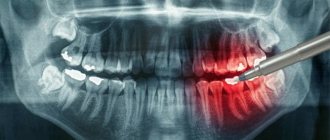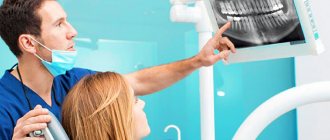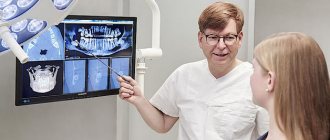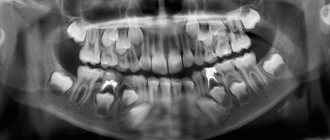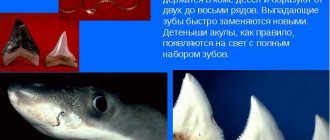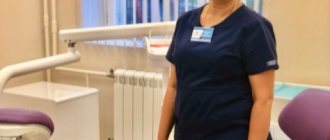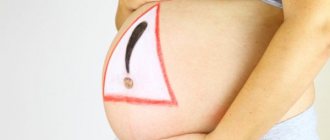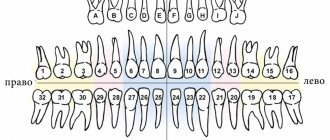A panoramic photograph of teeth or orthopantomogram (OPTG) is a radiographic examination technique that makes it possible to study in detail the anatomical features of both jaws, the condition of soft and bone tissue, dental roots, maxillary sinuses and joints. The study is carried out using equipment with reduced radiation exposure and does not pose any threat to the health of the body. Today we’ll talk about what this is, why a panoramic shot is needed and how often it can be taken.
What is OPTG and why is it performed?
Unlike a standard targeted photograph, an orthopantomogram allows you to obtain a fairly clear and detailed image of both jaws at once with the ability to study not only the condition of the teeth and their root system, but also the jaw bones, paranasal sinuses and other important anatomical structures. To understand what this diagnostic technique is, you first need to answer the questions: what does it do and why is it carried out. So, here's what the x-ray shows:
- deviations in the formation of occlusion - defects in bite, position, shape and size of teeth;
- early stages of caries and hidden foci of infection;
- periodontal pockets;
- neoplasms: cysts, granulomas, fibromas;
- hidden inflammatory processes and the extent of their damage;
- condition of the temporomandibular joint;
- impacted teeth that have not yet erupted - including wisdom teeth;
- condition of the root canals after treatment;
- diseases of the paranasal sinuses, for example, sinusitis.
The procedure is mandatory before orthodontic treatment, prosthetics and, of course, implantation. In the latter case, the image gives the doctor the opportunity to carefully examine the condition of the jawbone, select suitable locations for implants, or prescribe a bone tissue augmentation procedure. To understand what the result of OPTG looks like, take a look at the example image below. Important! It should be noted that today, within the framework of one-stage implantation techniques, the preparatory stage involves undergoing a computed tomography scan. This is a more modern X-ray method that allows you to obtain a three-dimensional image of the patient’s jaws with the possibility of layer-by-layer study of tissues, without distorting the actual sizes and shapes of the teeth. OPTG is also performed before treatment or removal of wisdom teeth or “eights”. The image will allow you to identify the exact location and position of the elements, detect hidden carious lesions and make a decision on the need for removal. In general, an orthopantomogram helps to carefully examine the clinical picture, make an accurate diagnosis and prescribe adequate treatment.
Orthopantomogram or panoramic photograph...
In the daily practice of a dentist of any specialty, for the most correct and complete diagnosis, there is often a need to obtain a panoramic X-ray of the patient’s oral cavity (survey X-ray, orthopantomogram). What kind of research is this, why do it, and what can be seen in such a picture? The answers to these and other questions can be found below in the article, which its author, Moscow colleague Stanislav Vasiliev, kindly shared with me.
What is an orthopantomogram and why is it needed?
An orthopantomogram (or “OPTG”, “panoramic image of the dental system”) is one of the types of diagnostic radiography. In dentistry, OPTG is of key importance - many types of treatment cannot be started without this diagnostic method. Technically, it is carried out as follows: the beam source (X-ray tube) and its receiver (film or digital sensor" move around the object under study in opposite directions. As a result, a very limited part of the object of study is in focus, everything else is blurred. Depending depending on the settings, we can get clear only a specific layer that interests us, and everything else in the image will be blurred. Panoramic images are taken using orthopantomographs. There are different orthopantomographs - film and digital. Film OPTG are almost history, while “digital” takes more and more place in modern dentistry. A modern orthopantomograph looks something like this:
This photo shows a Planmeca dental tomograph with a cephalostat. The latter is needed for teleradiography, a study that is widely used in orthodontics and maxillofacial surgery.
There is a widespread belief that this type of research is harmful. In fact, the volume of radiation even from a film orthopantomograph is such that it is possible to take panoramic photographs every day for a month without significant harm to health. And the radiation from digital devices is several times less than that of film devices, and the radiation dose received is much less than what you receive, for example, during a two-hour flight.
When is an orthopantomogram needed?
In principle, it is always needed. In dental treatment, prosthetics, orthodontic treatment, in surgery and implantology, even in rhinology when examining the paranasal sinuses, the value of panoramic images cannot be overestimated. However, in some cases it is impossible to navigate only by OPTG - nevertheless, we are transferring a three-dimensional image to a plane, and therefore distortions are possible. But orthopantomography should be considered as a primary x-ray examination, based on the results of which the tactics of both further, more in-depth diagnosis and treatment are built.
Orthopantomography of an adult.
For example, here's a snapshot:
Pay attention to the shape of the dentition. It turns out that the person in the picture seems to be smiling))). If we don’t see a smile (on the contrary, a “sad form”), then the picture was taken incorrectly and the amount of distortion in it will be very high. Such an image is not suitable for a good diagnosis.
They look at an orthopantomogram not as if in a mirror, but as if they were looking at another person. That is, the left side is on the right, and the right side is on the left. Sometimes, for convenience, the letter L (left) is placed on the left side or the letter R (right) on the right side. Or they sign the picture so that the patient’s data can only be read on one side.
An adult normally has 32 teeth. But you have repeatedly seen on my blog that we are discussing, for example, the treatment of the 44th tooth or the removal of the 48th tooth... How does this happen?
The fact is that each tooth, in addition to its name, has a number. According to the WHO classification accepted throughout the world, the dentition is divided into four segments. The top right segment is tens. Upper left - twenties, Lower left and lower right, respectively - thirty and forty. The numbering comes from the center of the dentition. It turns out that the right upper central incisor is the 11th tooth, the tooth following it (the right upper lateral incisor) is 12, the lower left second premolar is 35, and the lower right wisdom tooth is 48 teeth.
Although my friend, Valera Kolpakov, who now lives and works in the USA, said that they have a different classification: teeth are simply designated by a clockwise serial number. In our country such designations are very rare. Europe is still...
In the picture, yellow numbers indicate the numbers of an adult’s teeth. Now you can surprise your dentist by telling him that your pain is not just some lower molar, but specifically the 36th tooth. He will understand everything and look at you with such respect...
Some doctors name teeth by segment number. For example, “four, two,” lower left lateral incisor. This account is being vigorously imposed in institutes and universities, mainly by teachers of pre-retirement age. This classification is fundamentally incorrect. Why? Because initially this teeth counting system was intended for machine processing, and the machine works with the number “forty two” and not with the number “four two.” Therefore, you need to name the teeth correctly.
Most dental materials are made radiopaque. This is done so that the volume and location of this material on x-rays can be controlled. For example, filling materials for root canals are indicated by the letter A in the picture.
When an orthopantomogram of the dental system reaches a nearby ENT doctor, the latter immediately notices the penetration of the roots of the teeth into the maxillary sinus (letter B in the picture). Moreover, old dental textbooks mention this. In fact, the roots of teeth very rarely penetrate the maxillary sinus. Most often, they go around the edges of it so that the bottom of the sinus is between the roots of the teeth.
Orthopantomography gives a good idea of the location of wisdom teeth (letter C in the picture). Even targeted photographs do not provide a complete picture of the structure and localization of figure eights. Therefore, without performing an OPTG, I highly do not recommend undertaking the removal or treatment of “wise” teeth
In addition to teeth, OPTG also shows other structures that may be of interest to the dentist. For example, the mandibular canal, which runs through the thickness of the lower jaw and contains a neurovascular bundle, is highlighted in green. The latter innervates the teeth, the corresponding half of the lip and chin. This bundle exits through the mental foramen (indicated in dark green), which some “specialists” sometimes confuse with a cyst.
The borders of the maxillary sinuses and nasal passages are indicated in red. The image shows a curvature of the nasal septum and, as a consequence, asymmetry of the nasal passages. This is an indirect sign of chronic rhinosinusitis, including allergic nature.
The temporomandibular joints are indicated in blue. Normally, they should be symmetrical and have a certain shape. A noticeable difference in the shape of the joints, as well as their asymmetry, is one of the signs of chronic arthritis. In this image, the joints are almost symmetrical, therefore, the patient has no problems with the joints.
Radiopaque materials are highlighted in purple. The pictures clearly show all the fillings, the quality of the canal fillings, etc. The thin purple stripe on the front teeth are retainers installed after orthodontic treatment.
There are also structures on the OPTG that are not very interesting, but are still visible:
For example, the earlobes are highlighted in red, and the spinal column is highlighted with a blue dotted line against the background of the lower jaw. On either side of it is the hyoid bone. It comes into focus only in a lateral projection, and therefore is visible as two separate parts.
The horizontal line above the upper jaw is the hard palate, and on the sides of it the zygomatic bones are clearly visible. In the contour of the earlobes, one can distinguish the styloid process, the mastoid process and the opening of the external auditory canal. Thus, a panoramic image, although distorted, can give an almost complete picture of the state of the dental system - due to this, it is simply necessary in the high-quality diagnosis of dental diseases.
Orthopantomogram of a child.
Oddly enough, children have more teeth:
But the principle of their numbering is the same. Unless baby teeth are designated not by tens or twenties, but by fifties, sixties, seventies or eighties - as indicated in the picture. For example, tooth 75 is the left lower primary molar.
Under the milk teeth are the rudiments of permanent teeth (indicated by yellow numbers). At different ages they look different and have different shapes. In this image, for example, you may not see the crowns of the forming teeth 15, 25, but you can see the contours of the rudiment - therefore, there will be teeth.
The blue color in the picture indicates the mandibular canal.
Blue color - temporomandibular joints. Note how the relative position of the joint head, articular tubercle and socket differs from the structure of the adult joint.
The purple line is the contours of the maxillary sinus. In children it is relatively less than in adults. Therefore the voice is quieter and higher.
Green color - nasal septum and nasal turbinates. While relative symmetry is observed, however, due to injury, chronic rhinitis, allergies, or simply due to uneven growth, a curvature of the nasal septum is possible. As I already wrote, this is a risk factor for the development of chronic rhinosinusitis (sinusitis).
Red arrows and the letter A indicate artifacts from earrings. In some cases, jewelry in the form of piercings, chains, etc. can introduce significant distortions and complicate diagnosis. Therefore, before performing orthopantomography, it is better to remove all jewelry from the face and neck.
Of course, experts see much more ordinary people in the photographs. And radiologists are much more than ordinary specialists. It would be great if any radiologist would comment on this post.
In general terms, the diagnostic picture from panoramic images looks exactly like this. Now you can take your panoramic photo, look at it carefully and no longer say: “I don’t understand anything here.” After all, it’s better to see once than to hear a hundred times, right?
What equipment is used as part of the study?
This is not a new method - by now, OPTG has been actively used in dentistry for decades. And if earlier film cameras were used to obtain a panoramic image, today they have been replaced by more modern digital devices - orthopantomographs. The image is generated in a special computer program and, if necessary, can be printed on film. Images taken using digital equipment are more accurate and detailed, which virtually eliminates the risk of making an incorrect diagnosis. Answering the question about how long a panoramic photograph of teeth is valid, it must be said that the information received will remain relevant for several months - a maximum of six months. If more time has passed since the examination, the procedure must be repeated.
Indications and restrictions
The procedure is completely painless, carried out as quickly as possible and without any discomfort for the patient. OPTG is prescribed in the following cases:
- as part of implantation – carried out to study bone tissue, select implant models and places for their implantation. Based on the data obtained, the doctor will be able to draw conclusions about the advisability of building up the jawbone;
- to assess the quality of dental canal treatment and the condition of the roots - before prosthetics;
- before starting orthodontic treatment - before installing braces and other corrective structures;
- before an upcoming operation, complex removal, including wisdom teeth;
- to examine the dental system in children, assess the correctness of its formation and identify possible deviations;
- in order to determine the extent of damage to periodontitis and periodontal disease;
- to identify neoplasms in hard and soft tissues.
This procedure may be required in various clinical cases. X-ray diagnostics is not advisable in the first and last trimester of pregnancy - it is carried out only in the presence of emergency indications and with the permission of a gynecologist.
Features of conducting OPTG for children
We figured out what is visible in panoramic photographs and why they are taken, and found out that this is a completely safe diagnostic method. Now it should be noted that an orthopantomogram for children is carried out taking into account some nuances. A radiation exposure of 55 μSv (1 shot) is completely safe for a child, so a similar procedure is allowed from 5-6 years of age. The examination assumes that the patient must stand still for some time, but for young children this task can be quite difficult . When it comes to small patients, the procedure is carried out in exposure mode - the area of exposure is reduced, and the sensor is adjusted to a trajectory of movement corresponding to the small size of the jaws.
“My son also recently had a panoramic photo taken. He's 10, everything went great. Now there are new technologies everywhere, everything is safe. The procedure took less than a minute, and the doctors assured me that there was nothing wrong with it. How else can you start correcting your bite? The orthodontist prescribed OPTG for us. So far I’ve made the plate, but in a couple of years we’ll get braces. There’s no place here without pictures!”
In pediatric dentistry, OPTG is used to detect the rudiments of permanent teeth, assess the correctness of their formation, to diagnose adentia and identify malocclusions. Most often, this procedure is prescribed by an orthodontist before starting to correct defects in bite and teeth position. The procedure is completely safe for the child
Indications
The patient's need for a panoramic photograph of the teeth will be determined by the dentist. It is necessary to do it for a number of diseases of the oral cavity. Among them:
- inflammation of bone tissue;
- bite pathologies;
- tooth abscess;
- joint dysfunction;
- infectious diseases of the jaw;
- periodontal diseases;
- mechanical injuries.
OPTG is also necessarily prescribed when planning orthodontic correction of the dentition. A panoramic photograph allows you to see parts of the teeth that are located under the gums. With its help, the orthodontist can correctly draw up a treatment plan, predict its timing and select teeth that need to be removed (if necessary).
A panoramic photograph must be taken after sustaining jaw injuries (dislocations, fractures, etc.). Its main function is the diagnosis of dental diseases that cannot be determined solely by external signs. For this reason, OPTG is prescribed in the presence of symptoms indicating deep inflammatory and purulent processes.
The doctor gives a referral for a panoramic dental photograph after a visual examination of the oral cavity and collection of anamnesis. This takes into account the presence of pain (especially after canal filling), the nature of the discharge, dysfunction of the jaw joint and other symptoms.
A panoramic photograph is the most informative diagnostic procedure in pediatric dentistry. It is necessary for delayed teething or deviations in their formation. The picture clearly shows the rudiments of baby teeth already in the first months of a child’s life. With the help of OPTG, it is possible to predict bite pathologies and prescribe timely treatment.
With the help of OPTG, it is possible to diagnose diseases of the ENT organs, in particular, diseases of the maxillary sinuses and nasal passages. In this case, a panoramic image is prescribed for dizziness, fever, headache, and breathing discomfort.
Harm and degree of radiation exposure
Let's start with the fact that radiation exposure is measured in micro- or millisieverts - μSv or mSv, respectively. According to the resolution of the Ministry of Health of the Russian Federation, the permissible radiation dose within the framework of OPTG for an adult patient should not exceed 55 μSv, and for children under 15 years of age - 24 μSv 1 . It should be noted right away that only digital X-ray equipment meets these requirements, while film devices provide a slightly higher load. To determine how many times you can take a panoramic photo, you need to take into account that the maximum permissible radiation dose for an adult patient per year corresponds to 1000 μSv. However, it is still not worthwhile to partake in such procedures, even despite their obvious safety and harmlessness . X-ray irradiation has a negative effect on a weakened body, especially with repeated examinations. The children's body is more susceptible to this kind of influence, therefore it is strictly forbidden to exceed the permissible dosages when examining small patients. When contacting the clinic for OPTG, be sure to clarify what type of equipment is used and what the degree of radiation exposure from one image will be. Some private dentistry purchases cheap, outdated equipment, which can produce 2-3 times the recommended dose. The best option where you can take a panoramic photograph of your teeth is a specialized diagnostic center equipped with modern high-precision equipment.
Digital OPTG - description of the process
Now let's move on to consider the question of how a panoramic photograph of teeth is taken. To begin with, the patient is asked to remove all metal products from himself so that they do not affect the operation of the equipment and the final result. Next, the patient stands in the place indicated by the specialist, bites down on a special plate that ensures the immobility of the jaws, and after turning on the orthopantomograph, its moving part begins to rotate around the head. The procedure takes literally half a minute - the exact duration will depend on the type and newness of the equipment. Next, the resulting image is formed in digital form, that is, in a special computer program, or on film media (outdated version). A digital photograph can also be printed onto film if necessary.
What does an orthopantomogram show?
A panoramic photograph of the teeth helps to detect:
- dental anomalies;
- caries, including at the initial stage;
- periodontal pockets;
- tooth cyst;
- foci of inflammation.
Using an orthopantomogram it is possible to establish:
- the need to begin correcting malocclusion;
- condition of periodontal tissues;
- degree of formation of tooth roots;
- when installing implants (for example, the condition of the bone at the site of intended implantation);
- and much more.
Information content of the image and reading (deciphering) technique
If you undergo an examination at a specialized diagnostic institution, the finished image is usually accompanied by an explanation from a specialist with a list of detected problems. Many people are interested in how to decipher an image on their own, how to read it correctly, and whether it can be understood at all. It should be noted here that in order to correctly explain the results of OPTG, you need to have a good understanding of the anatomy of the maxillofacial apparatus, and without the appropriate education, little can be understood. It is better to entrust this task to an experienced, qualified doctor.
Orthopantomogram during implantation
As part of implant treatment, a panoramic image is taken more than once. First, an X-ray examination is carried out at the preparatory stage - the doctor carefully examines the resulting image, assesses the condition of the bone tissue, selects places for implants, and makes a verdict on the need for bone grafting. If we are talking about one-stage immediate loading protocols, then patients are usually sent for a computed tomography scan of the jaw - a 3D image provides more detailed information about the clinical picture.
3D diagnostics makes it possible to study a more detailed three-dimensional image
You will have to undergo a repeat examination after implantation. In this case, OPTG will give the doctor the opportunity to assess the quality of the operation performed, monitor the process of engraftment of artificial roots, and recognize possible complications in the later stages of their development. Several photographs may be required during the osseointegration period of the implants.
Preparing for a panoramic dental photograph
The procedure does not require special preparation. You can consume drinks, food and medicine - this will not affect the x-ray in any way. Immediately before the procedure, metal jewelry must be removed from the body. It is not recommended to drink alcohol.
When visiting a dentist, you must take panoramic and x-ray photographs from the last few years, as well as a medical history. With their help, the doctor will be able to track visible changes in the patient’s health status or compare treatment results.
X-ray radiation poses a possible risk to pregnant women. According to some studies, it can negatively affect the intrauterine development of the fetus. Pregnant women should tell their dentist about their pregnancy. In this case, carrying out OPTG depends on the ratio of possible risks and benefits.
What are the advantages and disadvantages of OPTG
An orthopantogram can significantly improve the quality of diagnosis, and today dental treatment is practically not carried out without radiography, except for minor problems. Among the undeniable advantages of the technique, experts highlight the following points:
- speed of the procedure - literally in a couple of minutes the image is ready for study;
- modern equipment makes it possible to adjust the height and trajectory of the emitter, which made diagnostics possible for children and wheelchair users;
- minimal radiation exposure and absolute safety for the body;
- high quality and accuracy of the obtained images;
- the ability to zoom in on the area under study and study it in detail on a computer monitor.
With an orthopantomogram, minimal radiation exposure is used. If we talk about the disadvantages, the main disadvantage of OPTG is obtaining a flat two-dimensional image. As a result, the image may slightly distort the dimensions of teeth, root canals and bone tissue. Such deviations can vary from 15 to 30%. To obtain a more accurate image, it is better to resort to computed tomography.
Approximate prices
How much a panoramic dental photograph will cost directly depends on whether the study will be carried out using film or digital equipment - in the latter case, the cost will be an order of magnitude higher. Approximate prices are given below:
- a photograph on a film camera – about 700 rubles;
- digital photo - from 1000 rubles and 150-200 rubles for printing on film.
We have already mentioned above that today, for a more detailed layer-by-layer study of the tissues of the jaw apparatus, computed tomography (CT) is performed. Essentially, this is the same panoramic photo, but much more detailed and in 3D format. An important advantage of this technique is the accurate transmission of the sizes and shapes of all elements of the dental system.
When is an orthopantomogram needed?
Orthopantomogram is used:
- in therapeutic dentistry. A panoramic photograph of the teeth allows you to identify periodontal problems, as well as carious cavities, and helps to create a comprehensive treatment plan;
- in surgical dentistry - before tooth extraction operations;
- in orthodontics. An orthopantomogram allows you to get a general idea of the state of your bite and select the right technique and hardware to correct it;
- in implantology – for planning implantation decisions.
